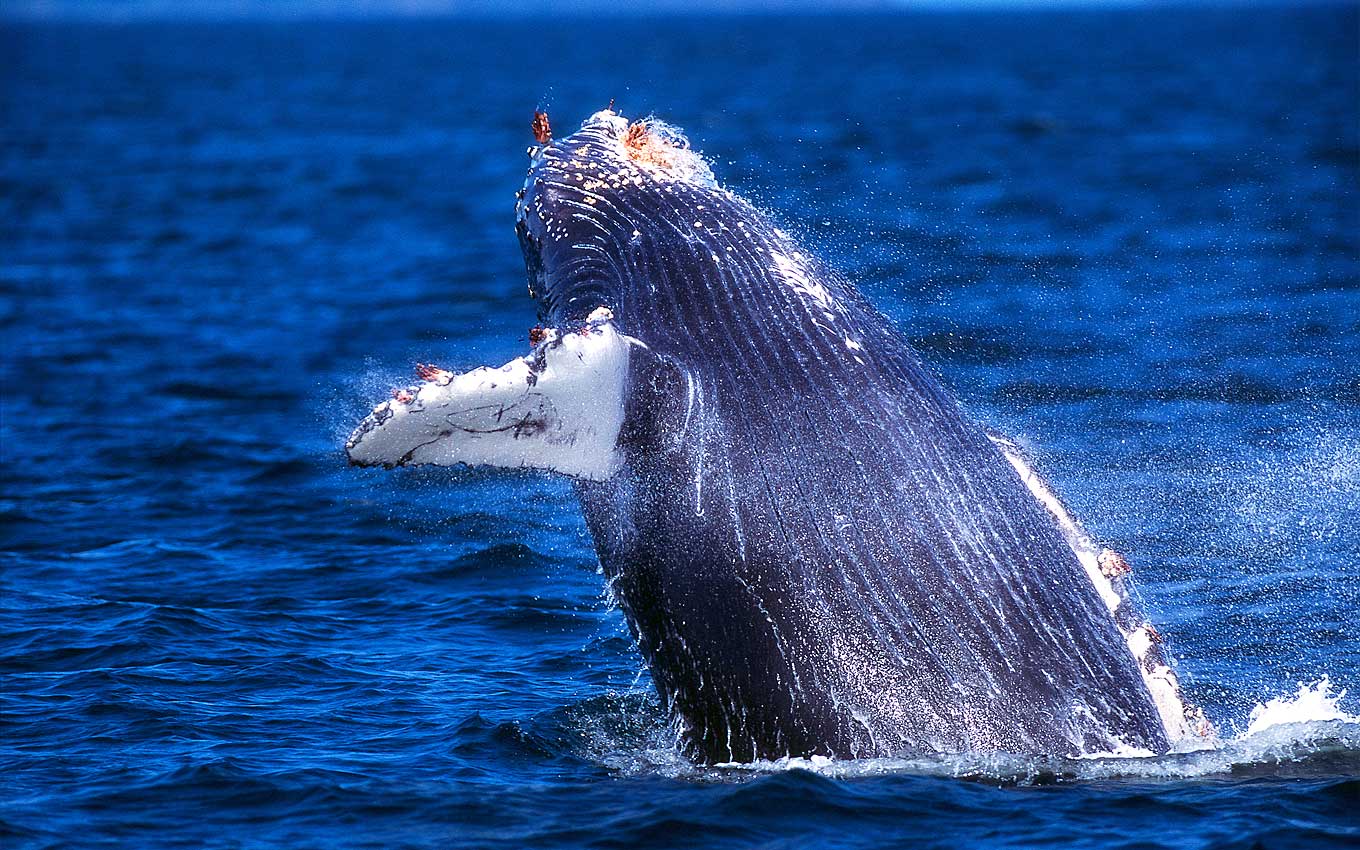
Kohola - The Hawaiian Humpback Whale
Hawaii Humpback whales are mammals belonging to the order Cetacea, which includes whales, dolphins, and porpoises. The common name "Humpback" refers to the high arch of their backs when the whales dive. Hawaiian Humpbacks weigh about 40 tons and can be up to 50 feet in length; females are slightly larger than the males. The average life span of a Humpback is between 30 and 40 years, with the oldest whale on record estimated to be 48 years old.

Interesting Humpback Facts
The Humpback Calf
Helped by its mother, a newborn Humpback instinctively swims to the surface within 10 seconds for its first breath. Within 30 minutes of birth the whale is able to swim, frequently riding in its mother's slip-stream.
Powerful Fluke
The fluke is the whales' powerful tail that propels the whale by moving up and down, rather than side to side like a fish. Humpbacks can dive for up to 30 minutes and reach depths of 500-700 feet.
Cetacean Cooperation
Dolphins and whales extend cooperative behavior to other species; dolphins are frequently seen swimming with whales during and after the birth of a calf.
Pectoral Fins
Humpback whales' pectoral fins are up to 15 feet in length with a bone structure similar to that of the human hand and arm.
Hearing without Ears
Whales employ an internal system of air sinuses and bones to detect sound because they lack external ears.
Tubercles
These fleshy knobs are found on the leading edge of a Humpback's pectoral fins and rostrum (the frontal portion of a whale's skull). The presence of tubercles on the pectoral fins enables Humpbacks to generate lift at angles 40% steeper than possible with a smooth surface. This effectively allows the whale to make sharper turns without losing its "grip" on the water. Wow!
FAQs
Where and how do I find whales?
To truly appreciate these massive creatures, you must venture into their environment. Whale watching cruises offer the best opportunity to get close to whales. From land on Kaua'i, try the Kilauea Lighthouse, Kealia Lookout, and other elevated coastal areas. Scan the horizon for the whales' characteristic blows and extra-large splashes (calm windless days make whale spotting much easier).
How close can we get to whales on a cruise?
Humpback whales are generally curious about objects in their environment; they will often approach and interact with boats. It's not uncommon for whales to come up alongside the boat, or even swim beneath it. Captains nicknamed these events "whale muggings" because legally they cannot move the boat until the whale has departed! From this close you can hear the blow (an exhalation at 300 mph) and the loud slaps of tails, flukes, and breaches.
What kind of boat is best?
It takes both a quality boat and an experienced, knowledgeable captain to deliver an exceptional whale-watch experience. Catamarans tend to be stable and can be designed so that everyone onboard enjoys a good view of the whales. Rigid hull rafts are smaller vessels that offer an intimate experience and a more exciting ride.
What are Hawaii's whale-watching laws?
Hawaii's "100 yard minimum rule" states that people (whether on a boat, kayak, swimming or by any other means) may not approach within 100 yards of a Humpback whale. Being wild animals, whales can approach us as they wish. Experienced captains know not to force a whale encounter but rather to slowly approach in a non-threatening manner and invite the whales in.
Why do whales breach?
Breaching is seen in many species of cetaceans and researchers are not sure of the reasoning behind this behavior. Scientists speculate that these aerial acrobatics could be a display of aggression, a means of dislodging barnacles, or perhaps for pure fun. Regardless of the "why" behind breaching, when you witness a 45-foot whale airborne it is sure to leave you in awe.
Preservation
Humpbacks have been heavily exploited in the past but are now recovering in most areas. Commercial whaling in the early 20th century reduced the global Humpback population by an estimated 90%. The species was on the brink of extinction in 1966 when a general moratorium on the hunting of Humpbacks was introduced which is still in force today. It is estimated there are currently 30,000-40,000 Humpback whales worldwide. Federal laws protect Humpbacks, however their habitat is under great pressure from over-fishing and pollution.
What You Can Do To Help
- Prevent marine debris and pollution. Pick up trash at the beach.
- Do not participate in irresponsible whale watching activities.
- Support sanctions against illegal whaling.
- Support marine-preservation research, programs, and legislation.
- Support eco-friendly companies and organizations like Save Our Seas, Patagonia, and Capt Andy's